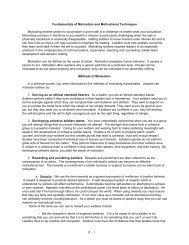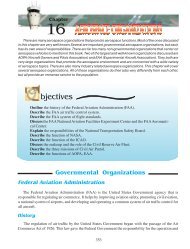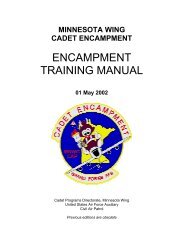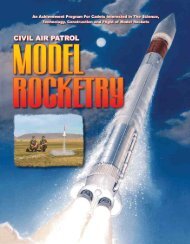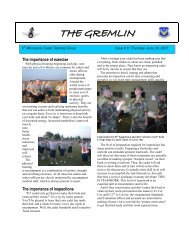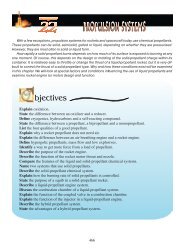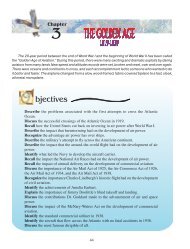In controlling performance, Chapin was able to usemeasures like profit and market share, to decomposethose objectives to subobjectives for lower levels of theorganization and to measure the performance of managersof particular models, areas, divisions. Cost accountingrules permitted him to compare plants within AMCand to compare AMC’s purchases, production, and evenadministration with the best practice in the industry.Managing External ConstituenciesAs chief executive officer, Chapin had to deal onlywith the Board. For Costle, within the executive branchbut beyond his agency lay many actors critical to theachievement of his agency objectives: the president andthe White House, Energy, Interior, the Council on EnvironmentalQuality, OMB. Actions each could take, eitherindependently or after a process of consultation in whichthey disagreed with him, could frustrate his agency’sachievement of its assigned mission. Consequently, hespent considerable time building his agency’s reputationand capital for interagency disputes.Dealing with independent external organizations wasa necessary and even larger part of Costle’s job. Since hisagency, mission, strategy, authorizations, and appropriationsemerged from the process of legislation, attention tocongressional committees, congressmen, congressmen’sstaff, and people who affect congressmen and congressionalstaffers rose to the top of Costle’s agenda. In thefirst year, top-level EPA officials appeared over 140 timesbefore some 60 different committees and subcommittees.Chapin’s ability to achieve AMC’s objectives couldalso be affected by independent external organization:competitors, government (the Clean <strong>Air</strong> Act that waspassed in 1970), consumer groups (recall Ralph Nader),and even suppliers of oil. More than most private managers,Chapin had to deal with the press in attempting tochange the image of AMC. Such occasions were primarilyat Chapin’s initiative and around events that Chapin’spublic affairs office orchestrated, for example, the announcementof a new racing car. Chapin also managed amarketing effort to persuade consumers that their tastescould best be satisfied by AMC products.Costle’s work was suffused by the press: in the dailyworking of the organization, in the perception by keypublics of the agency and thus the agency’s influencewith relevant parties, and even in the setting of theagenda of issues to which the agency had to respond.For Chapin, the bottom line was profit, market share,and the long-term competitive position of AMC. For Costle,what are the equivalent performance measures? Blumenthalanswers by exaggerating the difference betweenappearance and reality: “At Bendix, it was the reality ofthe situation that in the end determined whether we succeededor not. In the crudest sense, this meant the bottomline. You can dress up profits only for so long – ifyou’re not successful, it’s going to be clear. In governmentthere is no bottom line, and that is why you can be successfulif you appear to be successful – though, or course,appearance is not the only ingredient of success.” 20 Rumsfeldsays, “In business, you’re pretty much judged by results.I don’t think the American people judgegovernment officials this way…In government, too oftenyou’re measured by how much you seem to care, howhard you seem to try – things that do not necessarily improvethe human condition…It’s a lot easier for a Presidentto get into something and end up with a few days ofgood public reaction than it is to follow through, to pursuepolicies to a point where they have a beneficial effecton human lives.” 21 As George Shultz says, “In governmentand politics, recognition and therefore incentives go tothose who formulate policy and maneuver legislativecompromise. By sharp contrast, the kudos and incentivesin business go to the persons who can get somethingdone. It is execution that counts. Who can get the plantbuilt, who can bring home the sales contract, who cancarry out the financing, and so on.” 22This casual comparison of one public and one privatemanager suggests what could be done if the issue of comparisonswere pursued systematically, horizontally acrossorganizations and at various levels within organizations.While much can be learned by examining the chief executiveofficers of organizations, still more promisingshould be comparisons among the much larger numbersof middle managers. If one compared, for example, a regionaladministrator of EPA and an AMC division chief,or two comptrollers, or equivalent plant managers, somefunctions would appear more similar, and other differenceswould stand out. The major barrier to such comparisonsis the lack of cases describing problems andpractices of middle-level managers. 23 This should be ahigh priority in further research.The differences noted in this comparison, for example,in the personnel area, have already changed with the<strong>Civil</strong> Service Reform Act of 1978 and the creation of theSenior Executive Service. Significant changes have alsooccurred in the automobile industry: under current circumstances,the CEO of Chrysler may seem much morelike the administrator of EPA. More precise comparisonof different levels of management in both organizations,for example, accounting procedures used by Chapin tocut costs significantly as compared to equivalent proceduresfor judging the costs of EPA mandated pollutioncontrol devices, would be instructive…78
NOTES1. Selma J. Mushkin, Frank H. Sandifer, and Sally Familton, CurrentStatus of Public Management Research Conducted by or Supportedby Federal Agencies (Washington, D.C.: Public ServicesLaboratory, Georgetown University, 1978), p. 10.2. Ibid., p. 11.3. Though frequently identified as the author who established thecomplete separation between “policy” and “administration,”Woodrow Wilson has in fact been unjustly accused. “It is the objectof administrative study to discover, first, what government canproperly and successfully do, and, secondly, how it can do theseproper things with the utmost possible efficiency…” (Wilson, “TheStudy of Public Administration,” published as an essay in 1888 andreprinted in Political Science Quarterly, December 1941, p. 481). Foranother statement of the same point, see Brooks Adams, The Theoryof Social Revolutions (Macmillan, 1913), pp. 207-208.4. See Dwight Waldo, “Organization Theory: Revisiting the Elephant,”PAR (November-December 1978). Reviewing the growingvolume of books and articles on organization theory, Waldo notesthat “growth in the volume of the literature is not to be equatedwith growth in knowledge.”5. See Cases in Public Policy and Management, Spring 1979, ofthe Intercollegiate Case Clearing House for a bibliography containingdescriptions of 577 cases by 366 individuals from 79 institutions.Current casework builds on and expands earlier efforts on theInter-University Case Program. See, for example, Harold Stein, ed.,Public administration and Policy Development: A Case Book (Orland,Fla.: Harcourt Brace Jovanovich, 1952), and Edwin A. Bock andAlan K. Campbell, eds., Case Studies in American Government (EnglewoodCliffs, N.J.: Prentice-Hall, 1962).6. Luther Gulick and Al Urwick, eds., Papers in the Science of PublicAdministration (Washington, D.C.: Institute of Public Administration,1937).7. See, for example, Chester I. Barnard, The Functions of the Executive(Cambridge, Mass.: Harvard University Press, 1938), andPeter F. Drucker, Management Tasks, Responsibilities, Practices(New York: Harper & Row, 1974). Barnard’s recognition of humanrelations added an important dimension neglected in earlier lists.8. See, for example, “A Businessman in a Political Jungle,” Fortune(April 1964); “Candid Reflections of a Businessman in Washington,”Fortune (January 29, 1979); “A Politician Turned Executive,”Fortune (September 10, 1979); and “The Abrasive Interface,” HarvardBusiness Review (November-December 1979) for the views ofRomney, Blumenthal, Rumsfeld, and Shultz, respectively.9. John T. Dunlop, “Public Management,” draft of an unpublishedpaper and proposal, Summer 1979.10. Hal G. Rainey, Robert W. Backoff, and Charles N. Levine, “ComparingPublic and Private Organizations,” Public AdministrationOverview (March-April 1976).private to general propositions about similarities between publicand private institutions or management. See, for example, MichaelMurray, “Comparing Public and Private Management: An ExploratoryEssay,” Public Administration Review (July-August, 1975).14. These examples are taken from Bruce Scott, “American MotorsCorporation” (Intercollegiate Case Clearing House #9-364-001);Charles B. Weigle with the collaboration of C. Roland Christensen,“American Motors Corporation II” (intercollegiate Case ClearingHouse #6-372-359); Thomas R. Hitchner and Jacob Lew under thesupervision of Philip B. Heymann and Stephen B. Hitchener, “DouglasCostle and the EPA (A)” (Kennedy School of Government Case#C94-78-216), and Jacob Lew and Stephen B. Hitchner, “DouglasCostle and the EPA (B)” (Kenney School of Government Case#C96-78-217). For an earlier exploration of a similar comparison,see Joseph Bower, “Effective Public Management,” Harvard BusinessReview (March-April, 1977).15. U.S. Government Manual, 1978/1979, p. 507.16. Kenneth R. Andrews, The Concepts of Corporate Strategy(New York: Dow-Jones-Irwin, 1971), p. 28.17. “A Politician-Turned-Executive,” Fortune (September 10, 1979),p. 92.18. “Candid Reflections of a Businessman in Washington,” Fortune(January 29, 1979), p. 39.19. “The Abrasive Interface,” Harvard Business Review (November-December1979), p. 95.20. Fortune (January 29, 1979), p. 36.21. Fortune (September 10, 1979), p. 90.22. Harvard Business Review (November-December 1979), p. 95.23. The cases developed by Boston University’s Public ManagementProgram offer a promising start in this direction.ABOUT THE AUTHORGraham Allison is the “founding dean” of HarvardUniversity’s Kennedy School of Government. He isDirector of the Belfer Center for Science and InternationalAffairs and the Douglas Dillon Professor ofGovernment, at Harvard. A recipient of the Departmentof Defense’s highest civilian award, Dr. Allison served atthe Pentagon in the Reagan and Clinton administrations.From: Graham T. Allison, Jr., “Public and Private Management:Are They Fundamentally Alike in All UnimportantRespects?,” Setting Public Management Research Agendas:Integrating the Sponsor, Producer, and User, OPM Document127-53-1 (February 1980): 27-38. Used with permission.11. Richard E. Neustadt, “American Presidents and Corporate Executives,”paper prepared for a meeting of the National Academy ofPublic Administration’s Panel on Presidential Management, October7-8, 1979.12. Clinton Rossiter, ed., The Federalist Papers (New York: NewAmerican Library, 1961), No. 51. The word department has been replacedby branch, which was its meaning in the original papers.13. Failure to recognize the fact of distributions has led some observersto leap from one instance of similarity between public and79
- Page 1 and 2:
VOLUME FOUR STRATEGIC PERSPECTIVESL
- Page 3 and 4:
VOLUME FOUR STRATEGIC PERSPECTIVESL
- Page 5 and 6:
VOLUME FOUR STRATEGIC PERSPECTIVESL
- Page 7:
VOLUME FOUR STRATEGIC PERSPECTIVESL
- Page 10 and 11:
12CHAPTER 12INTRODUCTION TO STRATEG
- Page 12 and 13:
12.1 Strategic Leadership: Defining
- Page 14 and 15:
mandates or resolutions that would
- Page 16 and 17:
and ambiguity, aspiring strategic l
- Page 18 and 19:
12.2 National Security StrategyThe
- Page 20 and 21:
within our borders has always been
- Page 22 and 23:
front common challenges like violen
- Page 24 and 25:
and our strategy, not sector earmar
- Page 26 and 27:
thinking about organizations. She m
- Page 28 and 29:
A systemic approach to failure is m
- Page 30 and 31: The late W. T. Grant Company is a r
- Page 32 and 33: the resources - setting the directi
- Page 34 and 35: focal point for describing and inte
- Page 36 and 37: Consequently, we do not restrict th
- Page 38 and 39: paragraphs, Web pages, then edit an
- Page 40 and 41: Web, can be viewed as a CS attempt
- Page 42 and 43: How to evaluate users and contribut
- Page 44 and 45: 13CHAPTER 13LEADING PUBLIC &VOLUNTE
- Page 46 and 47: 13.1 Leadership for Volunteers:The
- Page 48 and 49: 13.2 Take Root: Volunteer Managemen
- Page 50 and 51: QualificationsClearly list educatio
- Page 52 and 53: and effectively track their volunte
- Page 54 and 55: • Understand rules for recognitio
- Page 56 and 57: • Send a birthday card.• Submit
- Page 58 and 59: and tested more than six decades af
- Page 60 and 61: specific interests of the donors, v
- Page 62 and 63: tain) tax-exempt status from the In
- Page 64 and 65: Smucker, 1999).The Internal Revenue
- Page 66 and 67: culture is necessary to ensure the
- Page 68 and 69: 13.4 The New Look of TransparencyBy
- Page 70 and 71: ees for a couple of reasons: One, i
- Page 72 and 73: 13.5 Public and Private Management:
- Page 74 and 75: TABLE 1:FUNCTIONS OF GENERAL MANAGE
- Page 76 and 77: 3. Career System. The model corpora
- Page 78 and 79: islative charter - the Clean Air Ac
- Page 82 and 83: 14CHAPTER 14AIRPOWER ASSTRATEGIC LA
- Page 84 and 85: 14.1 Strategic Air Power: Fulfillme
- Page 86 and 87: carry it out. Their daylight raids
- Page 88 and 89: you did not rely on strategic bombi
- Page 90 and 91: 14.2 Warden and the Air Corps Tacti
- Page 92 and 93: ecomes one of applying sufficient i
- Page 94 and 95: tification, and a Jominian claim to
- Page 96 and 97: courage the rapid and widespread ex
- Page 98 and 99: it to influence physical players in
- Page 100 and 101: 14.4 Basic Air Force DoctrineAF Doc
- Page 102 and 103: earthquake-stricken Haiti. The worl
- Page 104 and 105: perspective. Airmen do not divide u
- Page 106 and 107: Command and ControlCommand and cont
- Page 108 and 109: 14.5 Should the US Maintain the Nuc
- Page 110 and 111: form of human government.” 20 Dem
- Page 112 and 113: obtainable goal. See the Global Zer
- Page 114 and 115: 15CHAPTER 15ORGANIZATIONAL CULTURE
- Page 116 and 117: 15.1 Organizational CultureBy Doria
- Page 118 and 119: Review. This action strives to unco
- Page 120 and 121: gram will serve and then having the
- Page 122 and 123: ticipating the changes being made b
- Page 124 and 125: Many years of working with change p
- Page 126 and 127: At the least, the areas of concern
- Page 128 and 129: 15.4 Developing an Innovative Cultu
- Page 130 and 131:
CONCLUDING THOUGHTSIn an ever-chang
- Page 132 and 133:
global issues. Businesses that poss
- Page 134 and 135:
— Sees the big picture—the shif
- Page 136 and 137:
16CHAPTER 16STRATEGIC COMMUNICATION
- Page 138 and 139:
16.1 Principles of Strategic Commun
- Page 140 and 141:
16.2 The Art of NegotiationBy Brend
- Page 142 and 143:
16.3 Negotiating Effectively Across
- Page 144 and 145:
hidden areas can act as cultural ho
- Page 146 and 147:
and four conflict styles. Hammer be
- Page 148 and 149:
maintaining the relationship. As th
- Page 150 and 151:
25 Mitchell R. Hammer, “Chapter 1
- Page 152 and 153:
tural, socioeconomic, and psycholog
- Page 154 and 155:
for the win-win," during which time
- Page 156 and 157:
interests and, at worst, as a gun s
- Page 158 and 159:
Public diplomacy is surely about mu
- Page 160 and 161:
But public diplomats do not have th
- Page 162 and 163:
Photo courtesy of the familyThe LEA
- Page 164:
THE CADET OATHI pledge that I will



